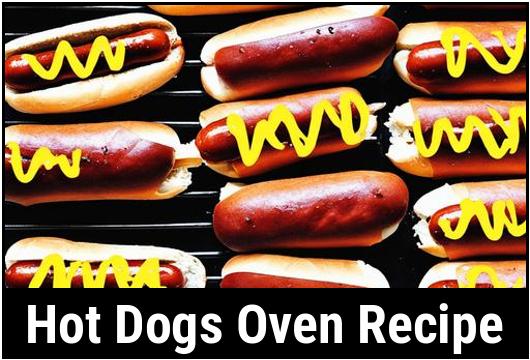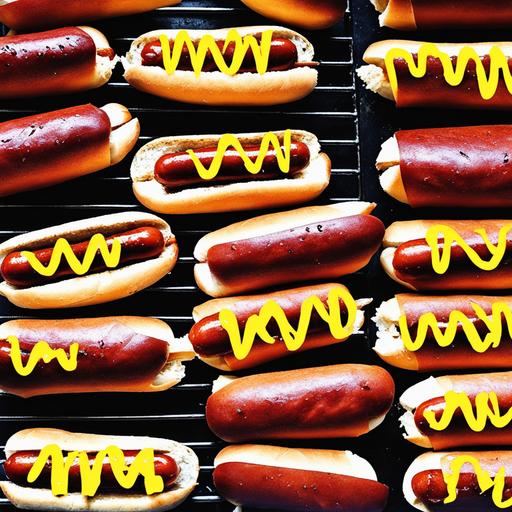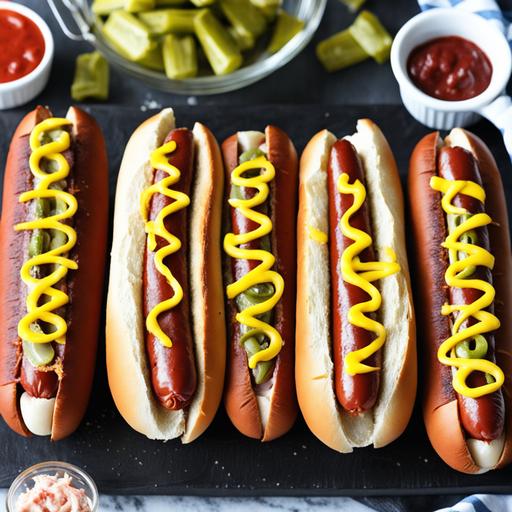
Hot Dogs Oven Recipe: A Delectable Delight
Hot dogs, a classic American comfort food, are loved by people of all ages. Whether it’s a backyard barbecue, a sporting event, or a casual dinner at home, hot dogs always find a special place on the menu. While grilling hot dogs is a popular cooking method, the hot dog oven recipe offers a convenient and efficient alternative. In this comprehensive guide, we will explore every aspect of this delectable delight – from the food science behind it, culinary details, selection, cleaning, preparation, tips, variations, doneness checks, and even potential pitfalls like overcooking or undercooking.
The Science Behind Hot Dogs
Before we embark on the culinary journey of hot dogs, let’s take a moment to appreciate the science behind them. Hot dogs are typically made from finely ground meat, combined with spices, salt, and additives. The meat used may vary, ranging from beef and pork to chicken and turkey. These ingredients are emulsified to create a homogenous mixture, which is then stuffed into casings before cooking.
When hot dogs are heated in the oven, the proteins in the meat undergo structural changes. These changes include protein denaturation and coagulation, resulting in a firm texture and enhanced flavor. The oven’s dry, radiant heat is perfect for achieving a uniform and consistent cook on the hot dogs.
Selecting the Perfect Hot Dogs
The key to a mouthwatering hot dog dish lies in selecting high-quality hot dogs. Here are some tips to consider before making your purchase:
- Look for Natural Casing: Opt for hot dogs with natural casings as they provide a delightful snap and texture. They also tend to hold their shape better during cooking.
- Choose the Meat: Decide on the meat you prefer – beef, pork, chicken, or turkey. Each offers a distinct flavor profile, allowing you to tailor your recipe to your preference.
- Quality Matters: Opt for hot dogs from reputable brands that prioritize quality ingredients. Read the labels to ensure that no artificial flavors, colors, or preservatives are used.
Remember, the quality of your hot dogs will greatly impact the final outcome of your recipe, so choose wisely.
Cleaning the Oven for Pristine Results

Before embarking on your hot dog oven adventure, it’s imperative to ensure your oven is clean. A clean oven prevents unwanted flavors and odors from transferring to your delicious hot dogs. Follow these steps for a pristine cooking environment:
- Remove the Racks: Take out any removable oven racks and wash them with warm soapy water. Rinse well and dry thoroughly before placing them back in the oven.
- Clean the Interior: Wipe down the interior of the oven, paying special attention to any visible food spills or stains. Spray a non-toxic oven cleaner and let it sit according to the manufacturer’s instructions. Scrub gently and wipe away the residue with a damp cloth.
- Attention to Detail: Don’t forget to clean the oven door, knobs, and control panel. Use a mild cleaning solution and avoid abrasive scrubbers to avoid damaging the oven’s finish.
By ensuring a clean oven, you set the stage for a truly delectable hot dog experience.
Preparing Hot Dogs for Oven Cooking

Now that your oven is clean and ready, it’s time to prepare the hot dogs for cooking. Follow these steps to ensure flavorful and juicy results:
- Thaw the Hot Dogs: If using frozen hot dogs, ensure they are fully thawed before cooking. Thawing can be achieved by leaving them in the refrigerator overnight or using the defrost function of your microwave.
- Prick the Hot Dogs: Before placing the hot dogs in the oven, use a fork to prick small holes on the surface. These holes allow steam to escape during cooking, preventing the hot dogs from bursting.
- Season to Taste: Enhance the flavor of your hot dogs by adding seasonings or marinades. Popular options include garlic powder, onion powder, paprika, or a simple combination of salt and black pepper. Allow the flavors to infuse by marinating the hot dogs for at least 30 minutes before cooking.
Tips and Tricks for Oven-Baked Hot Dogs

To elevate your hot dog oven recipe, consider the following tips and tricks:
- Bake on a Rack: Place the hot dogs on a baking rack set over a baking sheet. This setup allows the hot dogs to cook evenly and promotes better airflow around them.
- Add Moisture: To prevent dryness, place a shallow pan of water beneath the hot dogs on the lower rack of the oven. The steam generated will help keep the hot dogs moist during cooking.
- Broil for Extra Flavor: For a deliciously charred and slightly crispy exterior, broil the hot dogs for the last few minutes of cooking.
- Buns Matter: Don’t forget about the buns! Warm the buns in the oven for a few minutes before serving to enhance their taste and texture.
With these tips, your hot dogs will undoubtedly be a crowd-pleasing sensation.
Doneness Checks: Finding the Perfect Cook

Determining the doneness of oven-baked hot dogs is crucial to ensure a safe and enjoyable eating experience. Follow these guidelines to gauge their perfect cook:
- Internal Temperature: Use a meat thermometer to check the internal temperature of the hot dog. Ideally, it should reach 160°F (71°C) for optimal safety.
- Visual Inspection: Look for signs of browning and slight charring on the surface of the hot dogs. This indicates that they are properly cooked.
- Texture Test: Gently press a cooked hot dog with tongs or a fork. It should feel firm and spring back slightly.
Remember, undercooking can result in potential foodborne illnesses, while overcooking can lead to dry and rubbery hot dogs. Finding the sweet spot ensures culinary perfection.
Delightful Hot Dog Oven Recipe
Now that you have mastered the art of oven-baked hot dogs, let’s dive into a delightful recipe that will leave your taste buds longing for more.
Ingredients:
– 6 hot dog buns
– 6 hot dogs
– 1 tablespoon of vegetable oil
– 1 teaspoon of garlic powder
– 1 teaspoon of onion powder
– Salt and black pepper to taste
Instructions:
1. Preheat your oven to 400°F (200°C).
2. In a small bowl, mix the vegetable oil, garlic powder, onion powder, salt, and black pepper.
3. Use a fork to prick small holes on the hot dogs.
4. Brush the hot dogs with the seasoning mixture, ensuring they are evenly coated.
5. Place the hot dogs on a baking rack set over a baking sheet.
6. Bake for 15-20 minutes or until the hot dogs are heated through and slightly browned.
7. Optional: For added char and crispness, broil the hot dogs on high for the last 2-3 minutes of cooking.
8. Serve the hot dogs in the buns with your favorite toppings and condiments.
9. Enjoy your perfectly cooked oven-baked hot dogs!
Variations and Toppings:
– Experiment with different spice blends such as chili powder or smoked paprika for unique flavor profiles.
– Customize your hot dogs with a variety of toppings such as mustard, ketchup, relish, onions, sauerkraut, or cheese.
Feel free to adapt and modify the recipe to suit your taste preferences.
Avoiding Pitfalls: Overcooking and Undercooking
While oven-baked hot dogs are a delightful treat, it’s important to be aware of potential pitfalls that could result in less-than-optimal outcomes. Specifically, overcooking and undercooking are two common errors to avoid.
Overcooking: Keeping hot dogs in the oven for prolonged periods can cause them to dry out and become tough. Be mindful of the cooking time, temperature, and the specific characteristics of your oven to prevent overcooking.
Undercooking: Failing to ensure proper cooking can lead to health risks associated with consuming undercooked meat. Use a meat thermometer to confirm that the hot dogs reach an internal temperature of at least 160°F (71°C).
By understanding these potential pitfalls, you can ensure the perfect hot dog oven recipe every time.
Conclusion
In conclusion, the hot dog oven recipe offers a convenient and delicious alternative to traditional grill cooking. With its dry, radiant heat, the oven allows for even cooking, resulting in flavorful and juicy hot dogs. Remember to select high-quality hot dogs, clean your oven beforehand, and season to taste for the best culinary experience. Follow the provided recipe, experiment with variations and toppings, and, most importantly, cook your hot dogs to the recommend internal temperature.
So, embrace the hot dog oven recipe and let the aroma of perfectly baked hot dogs fill your kitchen! Enjoy this classic comfort food with your favorite toppings and share the joy with your loved ones.
Sources
FAQS On Hot Dogs Oven Recipe
What Ingredients Do I Need To Make Hot Dogs In The Oven?
To make hot dogs in the oven, you will need hot dog buns, hot dogs, and any desired toppings such as ketchup, mustard, onions, or relish.
How Do I Prepare The Hot Dogs For The Oven?
Preheat the oven to 375°F (190°C). Place the hot dog buns on a baking sheet and cut a slit down the middle of each bun. Place the hot dogs inside the buns.
What Is The Cooking Time For Hot Dogs In The Oven?
Once the oven is preheated, place the baking sheet with the hot dogs in the oven and bake for 10-15 minutes, or until the hot dogs are heated through and the buns are slightly toasted.
Can I Add Cheese To The Hot Dogs In The Oven?
Yes, you can add cheese to the hot dogs during the last few minutes of baking. Simply place a slice of cheese on top of the hot dog and continue baking until the cheese is melted and bubbly.
What Are Some Variations Of Hot Dogs In The Oven?
You can get creative with your hot dogs in the oven by using different types of hot dog buns, trying different types of sausages or hot dogs, and experimenting with various toppings and condiments to create unique flavor combinations.


